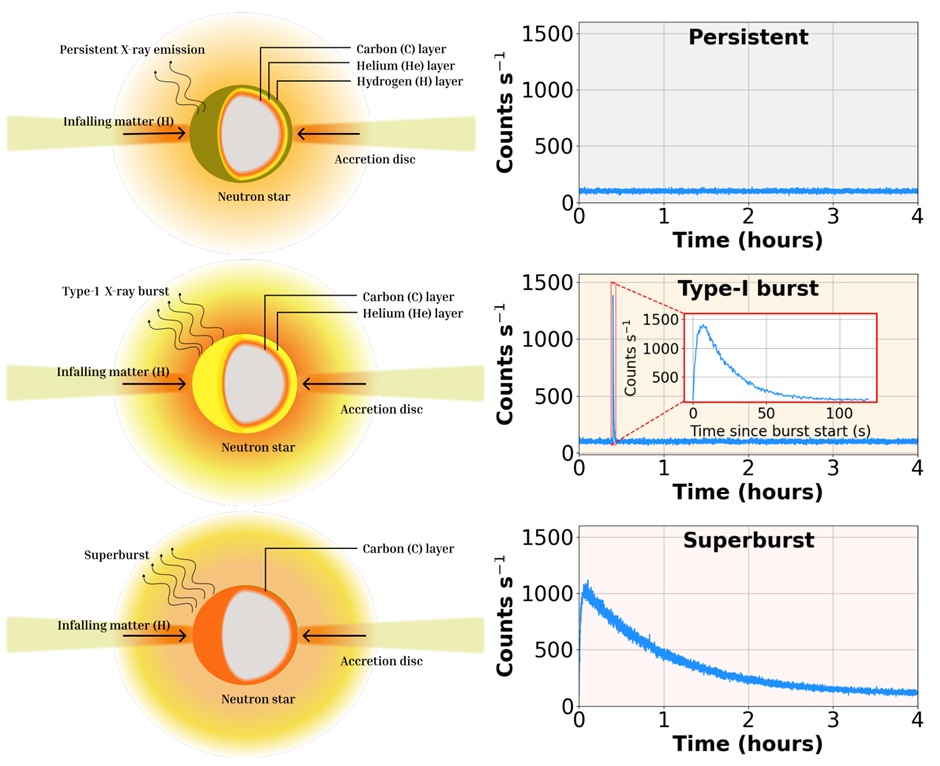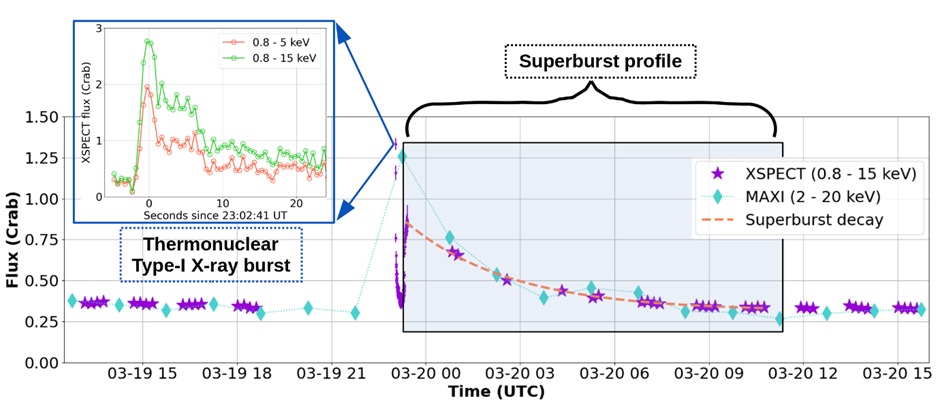Home : Science Promotion : Scientific Payloads : XSPECT
Last updated on: 24-April-2025
XSPECT/XPoSat detection of a thermonuclear ‘burst’, followed by a ‘superburst’
|
What are Neutron star X-ray binaries?Neutron stars are formed when massive stars run out of nuclear fuel and collapse after a supernova explosion. They weigh ∼ 1.5−2 Solar mass, and yet have a radius of only ∼ 10−20 km. For comparison, the radius of the Sun is 7 lakh km! This makes neutron stars the densest known objects in the universe. Composed mainly of neutrons, they possess densities comparable to nuclear density (∼1014 g cm−3) and radii ∼ 10 − 20 km. Neutron stars may be found in isolated or binary systems. In binary systems, the neutron star, due to its strong gravity, pulls matter from its companion (normal) star to form an accretion disc around it. The kinetic energy of the infalling matter is converted into thermal energy reaching temperatures up to a million Kelvin which is thousand times the Sun’s surface temperature, and hence emit in X-rays. Outbursts, bursts and superburstsSome of the neutron star X-ray binaries goes into ‘outbursts’ where its X-ray flux increases by several times, due to sudden increase in the mass accretion rate. These outbursts last for few weeks to months. Such systems also show X-ray ‘bursts’ lasting for few tens of seconds to minutes, and are characterized by a fast rise followed by exponential decay of the flux. Since normal stars are mainly composed of Hydrogen, the accreted matter in the form of Hydrogen (H) piles up on the neutron star surface and persistently fuses producing a thin layer of Helium (He) around it. At a critical temperature and Helium (He) mass, it ignites explosively giving rise to a thermonuclear flash, which is detected as an X-ray burst. Typical representation is shown in the middle panel of Figure 1. ‘Superbursts’ are believed to be caused by explosive burning of Carbon (C) layer underneath the Helium (He) layer. They are much rarer, last much longer and release much more energy than normal thermonuclear bursts as shown in the bottom panel of Figure 1.XSPECT observationsThe X-ray SPECtroscopy and Timing (XSPECT) payload onboard XPoSat was launched on January 01, 2024. XSPECT can provide pile-up free, long-term monitoring observation of cosmic X-ray sources. Long-term observations provide an unique opportunity to understand the evolution of transients and variable sources. Moreover, absence of pile-up (saturation) in XSPECT is a unique advantage which is not easily achieved by contemporary imaging X-ray telescopes. 4U 1608 − 52, located ∼ 4 kpc from Earth, is a binary system having a neutron star which accretes matter from a Sun-like companion star. This system goes into outburst once every 12– 18 months, and also exhibits thermonuclear bursts. Recently, this source entered into outburst in February end, providing an unique opportunity for observing this object with XSPECT and we triggered a long Target of Opportunity (ToO) observation to monitor the evolution of this outburst. 
Figure 1: (Left) Schematic representation of a Neutron star low-mass X-ray binary system during persistent emission from steady accretion (top), Type-I X-ray burst triggered by unstable helium burning (middle), a superburst driven by carbon ignition (bottom). (Right) Corresponding X-ray light curves over time, with a sharp, short-lived spike indicating a Type-I burst (middle), and a much longer superburst (bottom). The inset zooms into the Type-I burst, highlighting its rapid rise and exponential decay over timescales of seconds. On 19th March 2025, at 23:02:41 hrs UT, XSPECT detected a thermonuclear flash from this source (shown in Figure 2), reaching a peak flux of 2.5 Crab within a few seconds. Subsequently, the flux declined over the next 15 - 20 seconds as expected from a typical thermonuclear X-ray burst. However, within ∼ 16 mins of the decay, the source started brightening again and the flux increased abruptly by a factor of 2. Contrary to normal X-ray bursts, the decay of this burst lasted for ∼ 3 hours, making this a superburst. The occurrence of superburst in considered as a rare event and its closeness to the detection of Type-1 burst makes this observation highly important. Characterization of burst and superburst X-ray emissionFurther study on the nature of the thermonuclear burst reveals a neutron star temperature of ∼1.8 keV (∼ 20 million Kelvin) and radius ∼ 9.3 km which matches with the previously reported values. Interestingly, the nature of emission spectra of the superburst emission indicates a plausible Compton scattering process during the superburst to produce high flux and its decay over time scales of hours. 
Figure 2: XSPECT light curve of 4U 1608 − 52, showing a thermonuclear Type-I X-ray burst followed by a superburst. The burst, zoomed inside the inset, occurred around 23:02 hrs on 2025 March 19 and shows a typical rapid rise and exponential decay profile. It lasted for ∼ 15 − 20 seconds, but within ∼ 16 minutes of the burst decay, the source brightened again before subsequently decaying over a time scale ∼ 3 hours, making this a superburst. The fit to the exponential decay of the superburst is overlaid on the light curve. MAXI/GSC light curve is also shown for comparison. Comparison with other instrumentsThe Monitor of All-sky X-ray Image (MAXI) is an X-ray telescope mounted on the International Space Station. This superburst was also reported by the Gas Slit Camera (GSC) instrument of MAXI, with a decay time of ∼ 2.1 hours. The spectrum has been characterized using a single temperature blackbody, and found that the temperature declined from 1.7 keV (∼ 19 million Kelvin) to 1.2 keV (∼ 13 million Kelvin) during the superburst decay.ConclusionNotably, XSPECT observed yet another Type-I X-ray burst from this source, just five days after the superburst. Detailed studies of the source during the outburst, Type-I burst and superburst can reveal novel information about the nature of this system in particular, and the physics of systems in extreme environment in general. |






